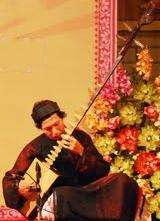Đàn đáy
The Đàn đáy is a Vietnamese plucked lute with three strings, a trapezoidal wooden body, and a very long wooden neck with ten raised frets. Players formerly used silk strings, but since the late 20th century have generally used nylon.[1][2]

Usage

It is used primarily in Northern Vietnam, and is one of the accompanying instruments used in ca trù.[3]
In the late 20th century, a modernized version of the electric bass guitar in the shape of the đàn đáy was developed for use in the neo-traditional music composed and performed at the Hanoi Conservatory. Unlike the đàn đáy, this instrument has a solid wooden body and metal strings, and without raised frets.
Etymology
In the Vietnamese language, đàn is a classifier used primarily to refer to string instruments, and đáy means "bottom." Thus, the instrument's name translates literally as "bottom string instrument." However, the instrument's body has no back. According to this website, the instrument was originally called vô để cầm, literally "bottomless stringed instrument."
References
- The Stringed Instrument Database
- Garland Encyclopedia of World Music "The đàn đáy is a long-necked three stringed lute"
- The Garland handbook of Southeast Asian music - Page 262 Terry E. Miller, Sean Williams - 2008 "This lute is the only stringed instrument used to accompany ca trù singing."